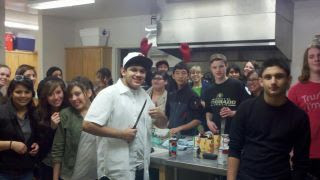AVID Volunteers
 AVID Center
AVID Center  Thursday, November 19, 2015 at 10:00AM
Thursday, November 19, 2015 at 10:00AM By Jennifer Wolfe, AVID Elective Teacher & Coordinator, Emerson Junior High School
Emerson Junior High School
“I’ve learned that people will forget what you said, people will forget what you did, but people will never forget how you made them feel.” – Maya Angelou
For a moment on Wednesday night, I was worried: 20 freshmen and sophomores, gas stoves, sharp knives, and the need to prepare and serve dinner for 40+ people in less than an hour? I questioned my choices.
This night—a culmination of a few weeks of planning and preparation for my AVID students—meant a lot to me. Building an AVID classroom community requires teamwork, empathy, compassion, and trust. It depends on kids being vulnerable, stepping out of their comfort zones, and looking at the big picture.
A believer in walking the talk, I want my AVID students to be active learners. The classroom isn’t the only place to teach these skills; I wanted my students to get into the community—outside of the comfort of room A-1—and put their skills to the test in the homeless shelter kitchen.
Earlier in the year, I had a community member involved with youth and volunteering come to the AVID class as a guest speaker. He talked about different levels of volunteering, depending on one’s comfort level. Some people start at a distance, like collecting money or items to donate. Others participate in a cause through an event, and the highest level of risk—and reward—happens when a person is directly involved.
So we made a plan. Kids could participate at any level: Some created the meal plan, some brought in the ingredients, and to my surprise, a majority actually showed up to cook and serve the meal.
As my students trickled into the shelter that night, I quickly jumped into teacher mode and soon had the industrial-sized kitchen humming with activity. Onions were chopped, meat was browning, cornbread was mixed up, and tables were being set.
Little-by-little, my nervousness was replaced by problem solving. No measuring cup? No problem; use an app to convert cups to tablespoons. No, I don’t know how to use an industrial-sized coffeemaker; find someone to help you. And they did.
After a while, any passerby might have thought that these kids were running the kitchen of the best restaurant in town. They were even wiping up after themselves! As they cooked, they bonded with each other and eased their own jitters about meeting the strangers waiting outside of the door.
The real lesson came after the food was prepared and the homeless guests lined up to be served. With eagerness and compassion, these children served men and women who were actually not so different from themselves. Slowly they ventured towards the dinner tables.
Sitting side-by-side and sharing a meal broke down the scariness. Stories began to move back and forth, child and adult bonding over simple food and a common desire to get to know each other’s story. I stood back and watched the transformation and beamed with pride at the acts of compassionate justice occurring before my eyes.
The next day, my AVID students were buzzing with conversation. Comments like, “Can we do it again, Mrs. Wolfe?” and “Wow, I met the most interesting guy, and he was only in his twenties” peppered the room. “I saw one of the guys downtown, and he said ‘hi’ to me,” a student shared. Their hearts were open, their minds expanding toward their next project. Such a simple thing—sharing soup and stories—but what a complex experience as a reward.
___________________________________________________________________________________________
Jennifer is a California mom, teacher, and writer who loves thinking deeply, loving fiercely, teaching audaciously & the extraordinary in the ordinary. Follow Jennifer Wolfe on her blog, mamawolfe http://jenniferwolfe.net or on Twitter: www.twitter.com/mamawolfeto2.
For more from Jennifer, see her blog:
Tips On Changing Middle School Behaviors, Einstein-Style
Reader Comments